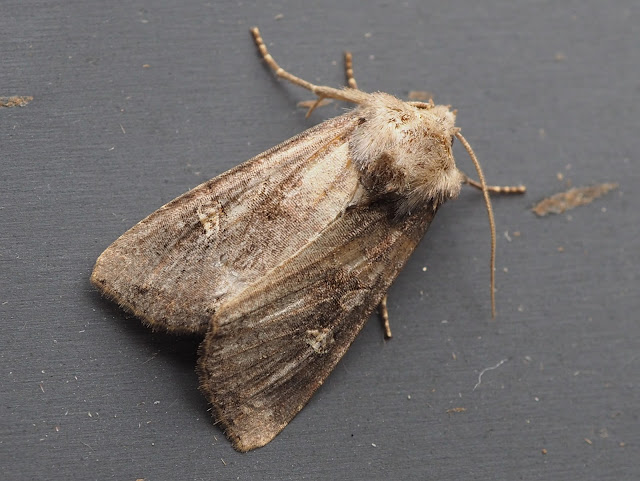 |
| Graphomya maculata, initial ID by Obsidentify, confirmed by IA (thank you). |
However, we can all recognise this plant as Hedge Bindweed, Calystegia sepium, but for Obsidentify it was White Campion Silene latifolia, at 100% confidence.
 |
| Hedge Bindweed, it is; it really is not White Campion. |
I use Obsidentify quite a lot. I'm not a good botanist and I usually (!) find it quite accurate for flowering plants. It is very good at macro-moths, surprisingly good at Diptera, very helpful with fungi and it can be surprisingly accurate with sawflies and bugs. But, and here's the thing, I always check the answer it gives, either with a book, a key, or with the appropriate expert online. With fungi, I often check Obsidentify with the Danish online AI tool (Obsidentify tends to give rather "simplistic" answers with fungi, try it, you'll see what I mean).
I am quite surprised that more folk don't use AI to at least get a general idea of what they are looking at. There are many requests for ID help in Facebook groups, particularly for macro-moths, where the AI tool would have got the answer. The Android tool Lens is good at garden plants, and pretty good at wild plants, but I don't especially like the way it provides output. Obsidentify provides very clear output, even if it is at times incorrect. I think these tools will only improve over time, however, I don't see them replacing books, keys and experts in the near future because they are only as good as the photo they are presented with for analysis. Obsidentify quite often has difficulty with scale, so it can struggle with trees and with mosses (it had a period of identifying most mosses as "Daffodil").
Eutomostethus luteiventris, identified initially at 100% by Obsidentify.Sawflies Symphyta can be tricky to identify. The keys are not especially easy and whilst there is available literature these are not the most accessible of beasts. I've identified a couple recently by employing Obsidentify and then going to the key. The above beast was put under the microscope, partially dissected, and keyed out. The answer was as I had been told by the AI initially. But, this species does have consistent abdominal markings that are distinctive, I just didn't know that, so the AI saved me many hours of ploughing through the key from the very beginning.
 |
| Female, Eutomostethus luteiventris, males are unknown in UK. |
I should have run this hoverfly through AI.
 |
| Syrphus sp, a female, but I identified this as Eupeodes corollae :-( thank you RM for putting me right). |
In my (feeble) defense, I am out of practice with hovers. But given this photo Obsidentify called it Syrphus vitripennis with 84% certainty. Actually, this is either S. vitripennis or S. torvus as it is a female and the hind femur is mostly dark, excluding S. ribesii. Microscopic examination of the eyes and wings are required to split female S. vitripennis and S. torvus.
Here's a female S. ribesii (which I got correctly) on the same clump of Knapweed Centaurea nigra.
 |
| Syrphus ribesii, female. |
I photographed the hovers at Comrie Community Woodland, where I was supposed to be engaged in tree care, but got distracted. (I did find some small Oaks that required a bit of vegetation suppression, but spent most of my time photographing bumblebees and hovers.)
 |
| Here's my favourite hover from the session, Chrysotoxum bininctum. |
I'm gradually working on my Pan-species Lists, entering on the new(ish) website. I spent a happy hour or so yesterday entering all the Diptera that I've ever recorded on iRecord. That exercise pushed me to 1,560 species. Beetles will be my next job, although lots of them are already on the list. During this activity, using the handy "Target Species" tool I found I'd missed Buff-bellied Pipit from my bird list, I will add that shortly. I've still quite a number of species to add, I would guess my total is likely to be around 1,800 species, but it could well be more. The list for the new garden now stands at 336 species, and whilst out at the Community Woodland I dipped Red Squirrel which scampered through the gate and across the back grass, darn! (I have seen one from the house, but not actually in the garden).
Here are some new moths, some not fully checked yet so please let me know if I've got any wrong.
 |
 |
| Crescent I thought, and Obsidentify agreed. |
I'm quite surprised I've not seen Crescent before, and I could have overlooked it in the past as it does occur in Orkney.
 |
| Barred Chestnut |
 |
| Beech-green Carpet |
 |
| Bulrush Wainscot |
The Barred Chestnut is thanks to Obsidentify, I was passing it off as Ingrailed Clay, but fortunately I checked it with the AI.























